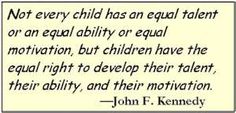As a nation, we demanded an accountability system for our public schools; President Bush gave us the accountability law “No Child Left Behind.” And he didn’t change it.
President Obama asked us to identify our lowest performing schools; we did. And the change we needed didn’t happen.
NOW, will we continue to allow the dismantling of the public education system —through the plans of well-financed lobbying groups— by keeping in place current policies that failed us. Will the country turn its back and walk away from “under-achieving schools”— knowing that the system failed to best serve a generation of students?
OR, will we fight like hell for the children left behind by the misguided decisions of our leaders?
It is our responsibility as a nation to not just identify and label schools, but to address the needs of our students throughout our land.
Despite what some want to believe, “equal educational opportunity” has never been offered in America. I believe that too many Americans have a hard time defining what it means and envisioning what it looks like. If I’m correct in that assumption, wouldn’t it make sense to stop rushing ahead without first establishing a vision for OUR education system?
We can begin as a nation by going back to the idea of providing excellent education for all as envisioned by the creators of The Elementary and Secondary Education Act (ESEA) of 1965. It provides a framework for what we now need. We need federal education law that we can all read, understand, and be a part of executing effectively and efficiently.
Americans seem to understand that children living in poverty have unmet needs that directly affect their ability to learn — such as those expressed by President Kennedy —“poor diets, unaddressed speech, dental and visual disorders.”
Meeting known resource gaps between the children of the poor and those of higher socioeconomic classes was precisely the main focus of ESEA.
Americans seem to understand that in most communities there are children from a spectrum of socioeconomic backgrounds and that it isn’t fair to offer opportunity to one group while undercutting another. Equal opportunity means offering them all a fair shot at obtaining a quality public education. Isn’t that why most of us want a public education system to exist?
Meeting the grander twin goals of quality and equality in educational opportunity was the primary guiding principles, the original aim, of ESEA.
 Americans seem to understand that the educating of a child occurs in a variety of community settings, that each community is unique, and that it makes sense to use resources that already exist while recognizing the need for assistance when and where it is necessary.
Americans seem to understand that the educating of a child occurs in a variety of community settings, that each community is unique, and that it makes sense to use resources that already exist while recognizing the need for assistance when and where it is necessary.
Meeting the need for a wide range of learning opportunities within a community, based on the belief that community improvement leads to educational improvement, was the philosophical basis of ESEA.
Americans seem to understand that a public system of public education requires a strong public institution that is both responsive to ever-changing educational needs and responsible for continuous improvement to safeguard against institutional entrenchment.
Meeting the needs of this large and diverse nation requires that all public education personnel —the public servants of the system, from teachers to counselors to leadership at all levels— be well-educated, trained, and informed in order to strengthen and improve the functioning of the institution. That was the method by which ESEA could guide fulfillment of our duty to establish and ensure equal educational opportunity in America.
The vision and framework are historical.
What is necessary right now is for each of us to call or write our U.S. representatives and request they reinstate the original aim of the Elementary and Secondary Education Act.
For America, this is what opportunity looks like.
The opportunity afforded us by the reauthorization of ESEA provides US with the chance to get it right.
(End note: A similar essay was published in Education News as ESEA and Opportunity in America )
